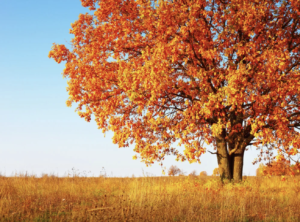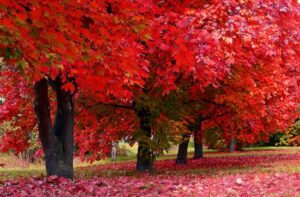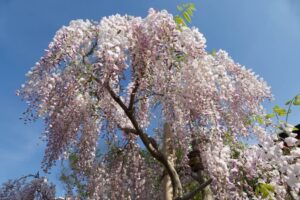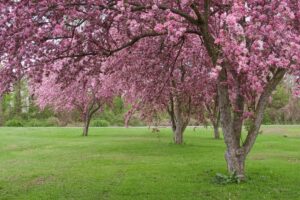The Top 5 Best Trees to Plant in Connecticut
This time of the year, we begin to see the leaves on our trees change, so what are the best trees to plant in the state of Connecticut and why? Check out the top five best trees to plant in Connecticut, courtesy of The Gardening Dad.
#1. Oak Tree Popular Varieties: White, English, Northern, Bur
Popular Varieties: White, English, Northern, Bur
Why Grow Oak Trees in Connecticut?
- Fast-Growing: The oak tree is one of the fastest-growing trees in Connecticut. It can grow up to 80 feet tall and only takes a few short years to provide shade for your yard
- Low-Maintenance: The oak tree is one of the lowest-maintenance trees that you can grow anywhere in Connecticut. It can be grown in almost any type of soil, can tolerate pollution, and thrives in both extreme heat and cold
- Beautiful Fall Leaves: If you want to add color in both the summer and the fall then grow oak trees. Expect beautiful shades of orange, red, and brown during the fall
What Could Harm Your Oak Tree?
- Pests: Young oak trees are very prone to being attacked by pests. Caterpillars, sawflies, oak worms, and borer are especially harmful to oak trees
- Disease: Young oak trees are also very prone to certain diseases and the necessary precautions should be taken. The diseases that can specifically harm your oak tree include chlorosis and hypoxylon cankers
Additional Resources
It should be noted that it is not recommended to grow oak trees if you are worried about their strong underground roots destroying the foundation of your house. It should also be noted that you should not plant your oak tree near your house due to large branches easily falling.
#2. Maple Tree Popular Varieties: Red, Norway, Sycamore, Sugar, Silver
Popular Varieties: Red, Norway, Sycamore, Sugar, Silver
Why Grow Maple Trees in Connecticut?
- Shade: Maple Trees are the perfect type of tree to provide shade for you and your house. They grow incredibly fast, have large branches and leaves, and can be planted almost anywhere in your yard
- Beautiful Colors: Maple Trees are one of the few trees that can provide beautiful colors in spring, summer, and fall. Expect amazing flower blooms in the spring, beautiful shades of green in the summer, and vibrant colors of orange, red, yellow, and orange in the fall
- Sturdy Tree: Maple trees are the sturdiest type of tree to grow in Connecticut. Because of its large root system maple tree can live over 100 years, can withstand cold, wind, heat, and there are very few diseases or pests that can destroy your tree
What Could Harm Your Maple Tree?
- Pests: While mature maple trees will not be affected by pests, young maple trees can become prone to damage from pests like deer, squirrels, and even birds. Deer can destroy the trunk of the tree and squirrels and birds can potentially eat the leaves of the tree
- Extreme Cold: Mature maple trees can survive long periods of sub-zero temperatures. Young maple trees on the other hand will die if the weather gets too cold within the first two years of its life. Because of this, you should wrap your tree in the winter with burlap
Additional Resources
There are very few reasons not to grow maple trees. They are perfect in rural areas, the suburbs, and even in certain cities. The only reason you would not want to grow a maple tree is if you have a small yard that is already crowded with trees.
#3. Japanese Lilac Tree Popular Varieties: Golden Eclipse, Ivory Pillar, Ivory Silk, Signature
Popular Varieties: Golden Eclipse, Ivory Pillar, Ivory Silk, Signature
Why Grow Japanese Lilac Trees in Connecticut?
- Perfect for Small Spaces: There are very few trees in this article that is good for small space. The Japanese Lilac Tree though is perfect for small and difficult spaces. You can control its size by pruning and maintaining it
- Beautiful Accent: Almost all of the trees on this list are the foundation on your yard and land. The Japanese Lilac Tree though is the perfect accent for shrubs, bushes, flowers, and any other tree or plant in your yard
- Low-Maintenance: The Japanese Lilac tree is the lowest-maintenance tree on this list. It doesn’t produce suckers, doesn’t need pruning, is not prone to insect infestations or diseases, and requires very little water
What Could Harm Your Japanese Lilac Tree?
- Shade: Japanese Lilac trees require full-sun. If you plant your tree in full-shade there is a chance it will not grow as it should and as a young tree it may potentially die
- Poor Soil: This type of tree requires well-draining, loose soil. It does not tolerate clay nor does it do well in compact soil. If you plant your tree in anything but well-draining, loose soil there is a good chance it will not be able to properly grow
Additional Resources
The Japanese Lilac Tree is not only one of the easiest and best trees to plant in Connecticut, but it is also one of the least expensive and most easily found trees throughout the entire state.
#4. Crabapple Tree Popular Varieties: Harvest Gold, Snowdrift, Golden Hornet, Sugar Tyme
Popular Varieties: Harvest Gold, Snowdrift, Golden Hornet, Sugar Tyme
Why Grow Crabapple Trees in Connecticut?
- Great Cross-Pollinator: Out of all the trees on this list the crabapple tree is the best cross-pollinating tree. It should be planted near apple, pear, and cherry trees to help attract pollinators and encourage more fruit growth
- Easy to Grow: The Crabapple tree is the easiest tree on this list to grow. You can plant it anywhere in your yard, in any type of soil, full sun or shade, and in any space
- Spring Blooms: All the trees on this list have pretty spring blooms, but none as beautiful as the Crabapple Tree. This tree will not only have beautiful shades of white, pink, and red blooms, but it will also have the longest blooms all spring and sometimes even fall
What Could Harm Your Crabapple Tree?
- Old Age: When it comes to Crabapple Trees there are very few if any things that can harm your crabapple trees. Old age is typically the only thing you have to worry about. When your crabapple tree gets older it is best to cut it down as it may attract harmful insects and pests to other trees by it
#5. Fir Tree Popular Varieties: Korean, Nordmann, White, Fraser
Popular Varieties: Korean, Nordmann, White, Fraser
Why Grow Fir Trees in Connecticut?
- Privacy: When it comes to adding privacy to your yard the fir tree is the number one choice in cities, suburbs, and rural areas. When planted together they not only add privacy, but will protect your yard from noise pollution and garden pests
- Low-Maintenance: Like many other trees on this list the fir is incredibly low-maintenance. Unlike non-conifer trees though this type of tree is incredibly hardy against cold weather and warm weather, requiring very little water
- Attract Animals: The fir is a great type of tree to not only attract animals, but is the perfect nesting spot for squirrels, rabbits, deer, and even many types of birds.
What Could Harm Your Fir Tree?
- Humans: Because fir trees are so incredibly hardy, it is very tough to kill them. The number one cause of fir tree death is humans. It is usually because we overwater fir trees too much, we prune them at the wrong time, etc
- Disease: While it is rare, disease can stunt your fir tree growth and even kill it. The most common types of fir tree diseases include Swiss Needlecast, White Pine Blister Rust, and Dwarf Mistletoe
Additional Resources
The biggest tip when purchasing and growing a fir tree is deciding what type you want. Some fir trees only grow 2 or 3 feet tall and others can grow 40 to 50 tall. Some of slim and others are very wide. Carefully pick a fir tree that meets your needs.